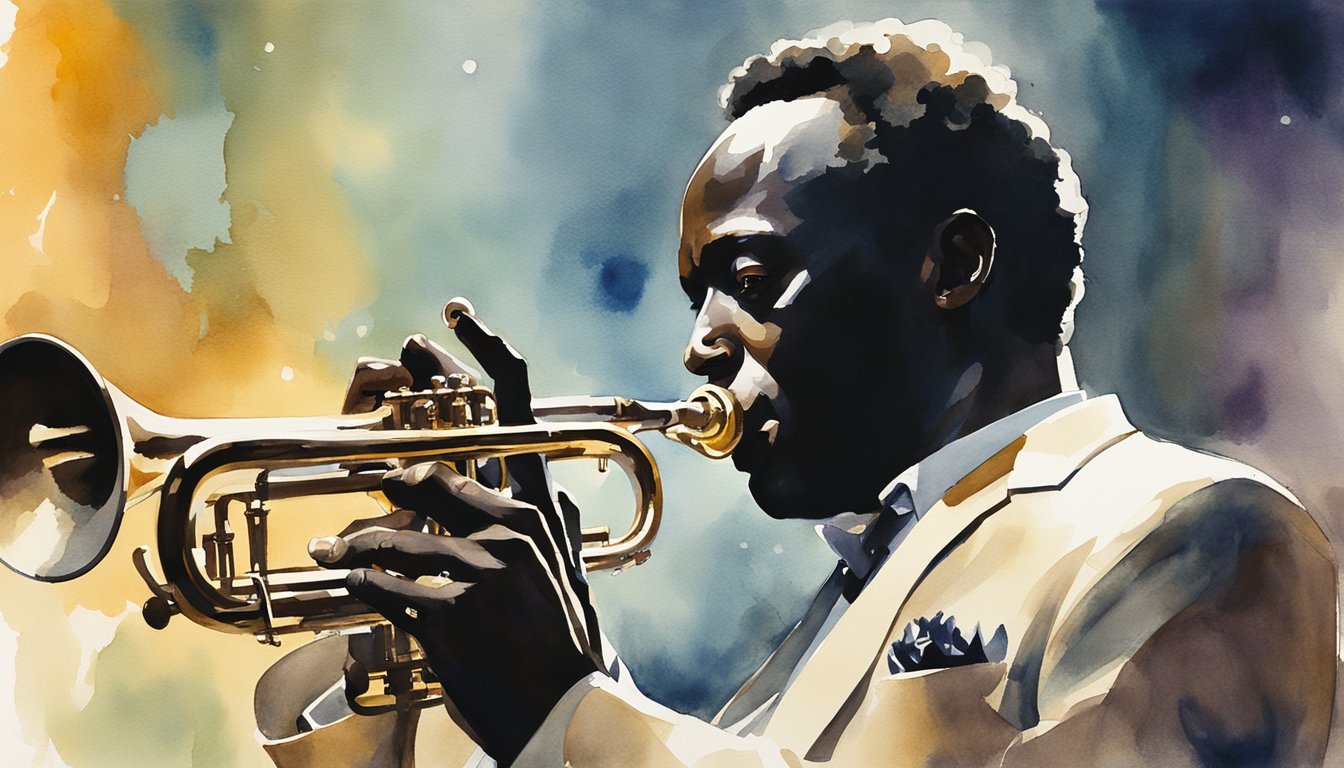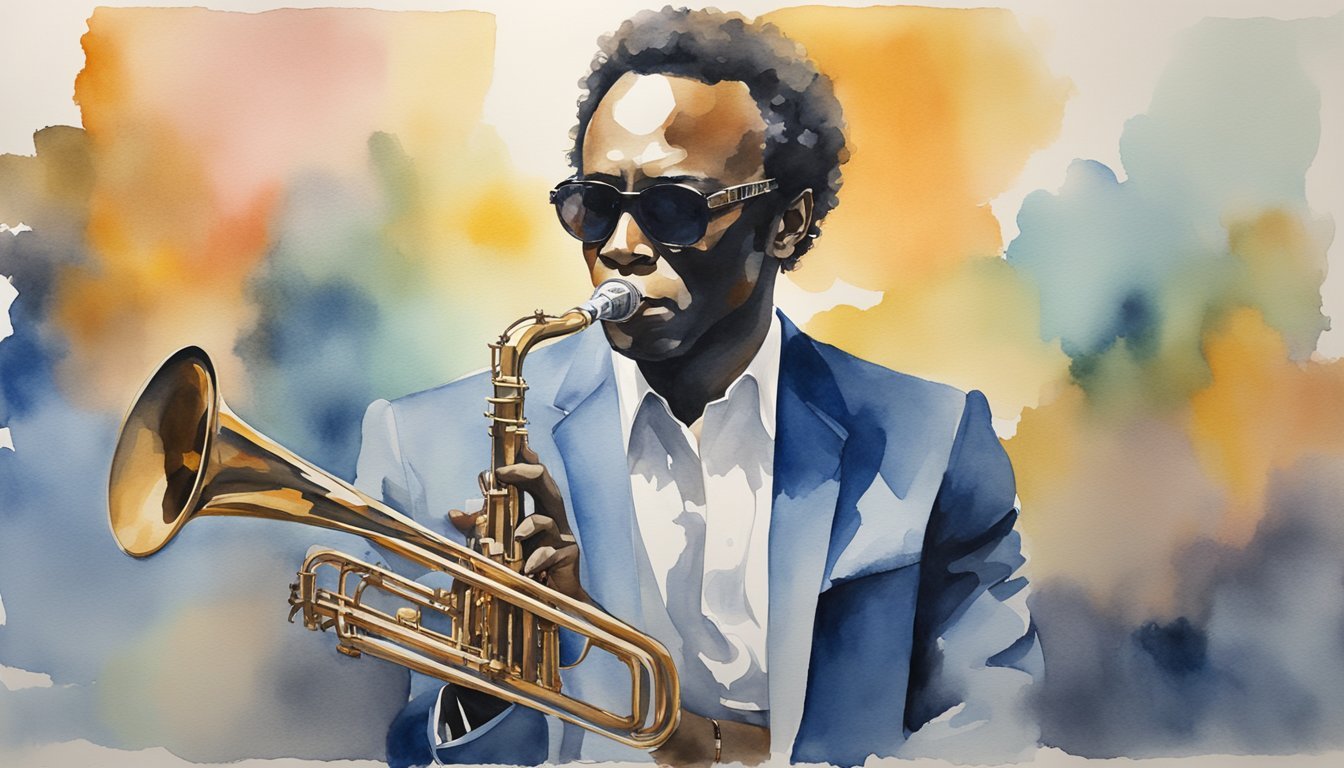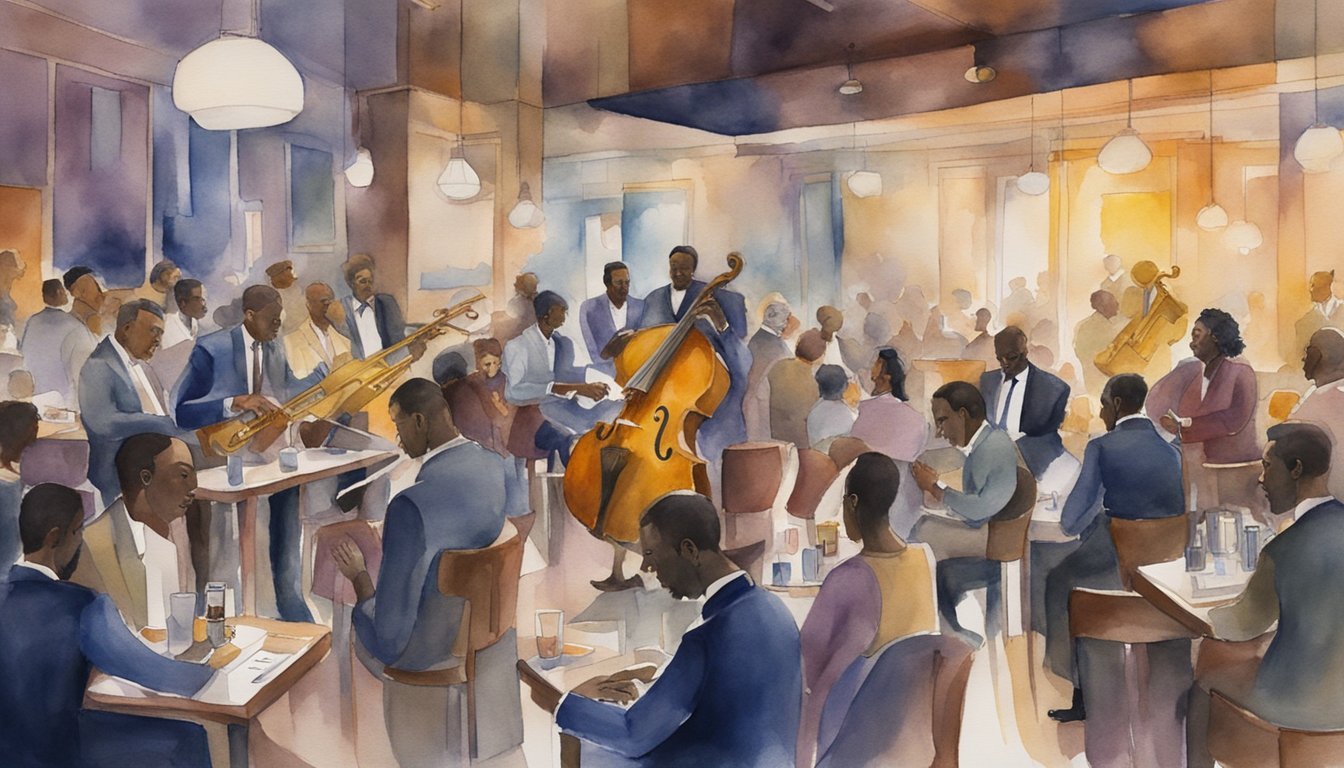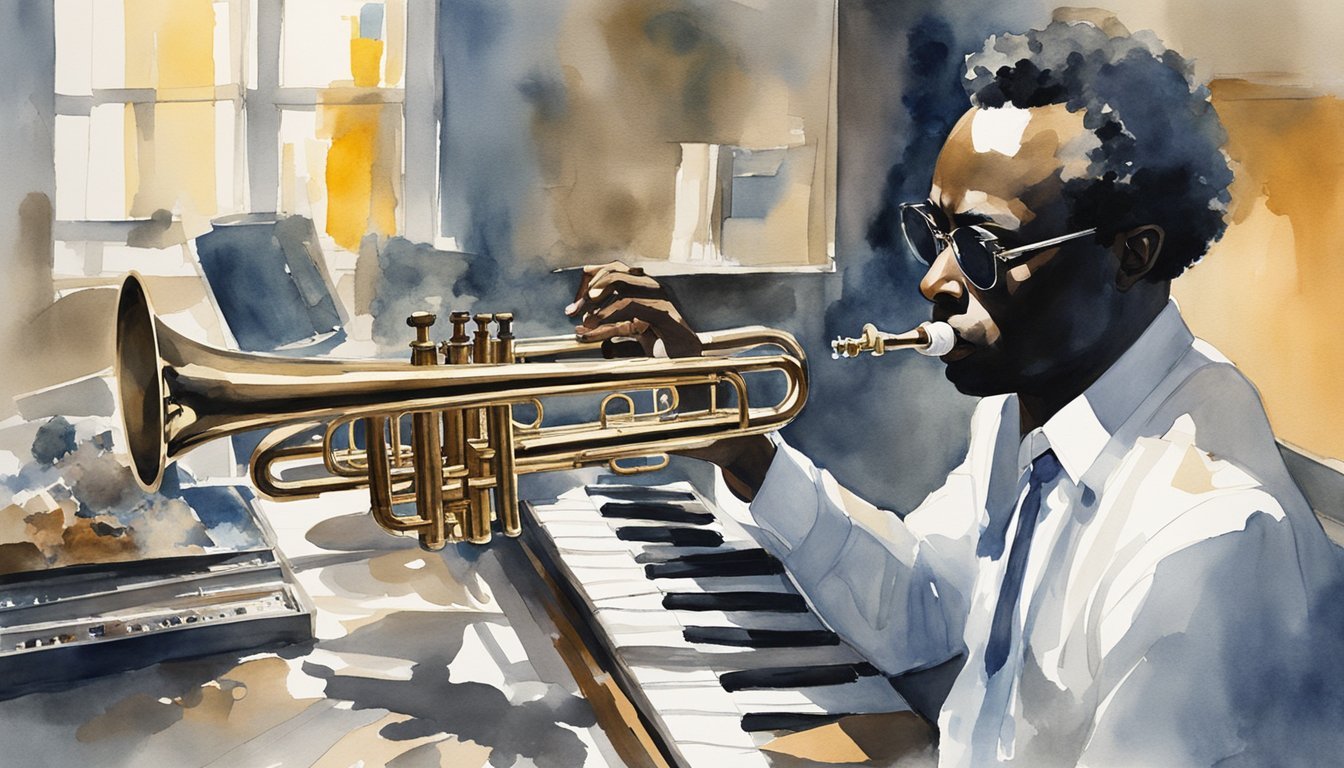Biography of Miles Davis: The Man Behind the Music

Miles Davis was much more than a jazz trumpeter; he was a revolutionary figure who shaped the evolution of jazz over five decades. From his early days with the Charlie Parker Quintet to his groundbreaking album “Kind of Blue,” Davis constantly pushed the boundaries of what jazz could be.
His journey from East St. Louis, Illinois, to becoming a music icon is filled with innovation and passion.

Davis’s upbringing in a musical household and his education at Juilliard molded him into a stellar musician early on.
He was not just influenced but inspired by legends like Thelonious Monk and Charles Mingus, contributing to his unique sound.
Following his Manhattan debut in 1946, Davis’s career skyrocketed, producing numerous masterpieces and collaborating with the best in the jazz world.
One of the pivotal moments in his career was the release of “Kind of Blue” in 1959, an album that still resonates with music lovers today.
Davis’s quintets and his willingness to explore different musical genres have left an indelible mark on the music industry.
His impact continues to be felt, even years after his passing in 1991.
Key Takeaways
- Miles Davis revolutionized jazz and influenced many musicians.
- He attended Juilliard and worked with jazz legends like Charlie Parker.
- Davis’s album “Kind of Blue” remains a jazz masterpiece.
Early Life and Education

Miles Dewey Davis III was born into a well-off family, with early experiences in both Alton and East St. Louis shaping his future.
His musical journey took a significant turn when he attended the prestigious Juilliard School.
Childhood in Alton and East St. Louis
Miles Davis was born on May 25, 1926, in Alton, Illinois.
His father, Miles Dewey Davis Jr., was a successful dental surgeon, and his mother, Cleota Mae, was a music teacher.
The Davis family moved to East St. Louis, Illinois, when Miles was young.
In East St. Louis, Davis had a comfortable childhood, surrounded by music.
His father’s prosperous career as a dentist provided well for the family.
Alton and East St. Louis both exposed him to different social and cultural environments, deeply influencing his love for music.
Musical Training at Juilliard School
At 18, Miles Davis moved to New York City to attend the Juilliard School 🎺.
This prestigious institution was known for its rigorous musical training.
Though Davis felt the school’s curriculum overly focused on classical music, he still benefited from the technical skills acquired during his time there.
In New York, Davis also dove into the city’s vibrant jazz scene.
He met influential figures like Charlie Parker and began performing in clubs.
His formal education and real-world experiences combined to shape his unique style.
Eventually, Davis left Juilliard to focus entirely on his burgeoning jazz career.
For more about the spiritual journey in music, check this secret spiritual knowledge link!
Beginnings of a Jazz Icon
Miles Davis made early waves in jazz through key collaborations and by forming his own band.
These efforts were pivotal in shaping his unique sound and significant contributions to the genre.
Collaborations with Charlie Parker
In the mid-1940s, Miles Davis moved to New York City, where he attended the Juilliard School.
However, the city’s vibrant jazz scene soon captivated him, leading him to drop out. 🎷
He began playing with the innovative saxophonist Charlie Parker.
Alongside Parker, Davis was introduced to Bebop, a new, fast-paced jazz style.
This collaboration significantly shaped his early career.
Working with Parker, Davis participated in recording sessions that produced classics like “Now’s the Time” and “Billie’s Bounce.” His time with Parker’s quintet made Davis one of the key players in the Bebop movement.
These early collaborations also set the stage for Davis’s later work.
Formation of His Own Band
After his stint with Parker, Davis felt inspired to create his own sound.
He formed a nonet, a nine-piece band, which was unusual compared to the smaller groups common in Bebop at the time. 🌟
In 1949, this nonet recorded the Birth of the Cool, an album that diverged from the hectic style of Bebop.
Instead, it focused on a relaxed and melodic approach.
This album became a major influence on the development of cool jazz.
Davis’s decision to form his own band was a turning point.
It allowed him to experiment with different styles and become a central figure in the jazz community.
This move set the stage for his long and influential career in music.
For more insights on secret spiritual knowledge related to music and beyond, you can explore this link. 🌌
Revolutionizing Jazz
Miles Davis was at the forefront of jazz’s evolution.
His work in modal jazz and jazz fusion significantly changed the genre forever.
The Creation of Modal Jazz
Miles Davis dropped Kind of Blue in 1959.
This album was a game-changer 🎷.
He and his band shifted from the complex chord progressions of bebop to a simpler approach, using scales instead.
This shift allowed for more freedom in improvisation.
Key tracks like “So What” and “Freddie Freeloader” beautifully showcase this modal jazz style.
The modal approach meant musicians could express themselves more deeply and personally.
Davis’s use of modes opened new possibilities in jazz.
Advent of Fusion with Bitches Brew
In 1970, Davis released Bitches Brew, which marked the start of his venture into jazz fusion.
This album blended jazz with rock, and funk elements, creating something entirely fresh 🎸.
Key tracks include “Pharaoh’s Dance” and “Bitches Brew.”
Davis’s band included electric guitars and keyboards, which wasn’t common in jazz.
This new sound attracted many young listeners and expanded the audience for jazz music.
From there, jazz fusion grew into a significant subgenre.
Explore the spiritual knowledge that influenced him 🌌.
Miles Davis continued to push boundaries, constantly evolving jazz with each project.
His contributions remain some of the most important in jazz history.
Milestones and Masterpieces
Miles Davis made some of the most iconic jazz albums that shaped the genre.
His work includes groundbreaking collaborations and timeless records that continue to influence music today. 🎺
Iconic Album: Kind of Blue
Kind of Blue is a true masterpiece in jazz history.
Recorded in 1959, it features an extraordinary lineup, including Bill Evans on piano, John Coltrane on tenor sax, and Cannonball Adderley on alto sax.
Miles Davis created a modal jazz album that broke away from traditional structures.
The album’s tracks, like “So What” and “All Blues,” became standards.
This record sold millions of copies and is still studied and admired by musicians around the globe.
If you’re interested in secret spiritual knowledge, you can find more here.
Collaborative Projects
Miles Davis had several important collaborations that shaped his career and jazz as a whole.
In 1957, he released Miles Ahead, an album arranged by Gil Evans.
This collaboration brought a new, lush orchestral sound to jazz.
His sextet, featuring legends like Bill Evans, John Coltrane, and Cannonball Adderley, produced unforgettable performances.
These collaborations allowed Davis to explore and push the boundaries of jazz, resulting in innovative sounds that continued to influence the genre for decades. 🎷
The Quintet and Beyond
Miles Davis was a legendary jazz musician whose work with various quintets marked groundbreaking shifts in the genre.
This section focuses on his influential Second Great Quintet and his expansion into new musical directions.
Second Great Quintet
The Second Great Quintet of Miles Davis was legendary, featuring top talents like Wayne Shorter on saxophone, Herbie Hancock on piano, Ron Carter on bass, and Tony Williams on drums.
This group recorded iconic albums such as E.S.P., Miles Smiles, and Nefertiti.
Their music was known for its complex compositions and innovative use of rhythm and harmony. 🎷
Tony Williams, only 17 when he joined, added a youthful energy to the group.
Ron Carter’s bass lines were the backbone, keeping everything tied together.
Wayne Shorter and Herbie Hancock complemented each other perfectly, providing a rich, harmonic backdrop for Miles’ trumpet.
Expanding Musical Directions
Miles Davis didn’t stop at just forming the Second Great Quintet.
He continuously pushed musical boundaries even further.
After the quintet, he ventured into jazz fusion, blending jazz with rock, funk, and electronic music.
His album Bitches Brew in 1970 was a turning point.
This period also introduced electric instruments into his work, making the sound more modern and different from traditional jazz. 🎸
Davis’ explorations during this period were influenced by his interest in spiritual knowledge.
For more on this journey, check the insights about secret spiritual knowledge.
Miles’ adaptability and willingness to experiment helped keep his music fresh and exciting for both old fans and new listeners alike.
Challenges and Obstacles

Miles Davis faced numerous challenges in his life, including battles with addiction and significant health and personal struggles.
These obstacles both shaped his music and personal life.
Battles with Addiction
Miles Davis struggled with heroin addiction, which had a big impact on his career and personal life. 🥀 His addiction began in the late 1940s, leading to a period of heavy drug abuse.
This dark phase affected his productivity and relationships within the jazz community.
He even took time off to recover, leading to a difficult detox process.
He managed to kick the heroin habit in the mid-1950s but later battled a cocaine addiction.
This second wave of drug abuse brought on more hardships and strained relationships.
The challenges with drugs were a recurring theme in his life, but they also provided depth and emotion to his music.
Health and Personal Struggles
In addition to his battles with addiction, Miles Davis dealt with significant health issues.
He suffered from hip problems, which led to surgeries and physical pain.
Davis also had a history of ulcers and pneumonia, which further complicated his health.
His personal life was equally turbulent.
Miles had multiple marriages and went through several divorces, which added emotional stress.
These struggles often made their way into his music, giving it a raw and emotional edge.
Despite these challenges, Davis remained a pioneering figure in jazz, using his experiences as fuel for his creative fire.
His story is a testament to resilience and the transformative power of music, resonating with many who face their own battles. 🌟
For more on overcoming personal challenges, check out this secret spiritual knowledge.
Innovations in Jazz and Technology

Miles Davis was a pioneer in blending jazz with new technologies.
He constantly pushed the boundaries, incorporating electric instruments and pioneering the use of synthesizers.
Adoption of Electric Instruments
In the late 1960s, Miles Davis began to incorporate electric instruments into his music, which was a big shift from his earlier acoustic work.
This change was most notably seen in his album Bitches Brew. 🎷 Here, he used electric pianos, electric guitar, and electric bass, which gave his music a fresh, electrified sound.
His collaboration with artists like Jimi Hendrix also influenced his use of electric instruments.
Davis was fascinated by Hendrix’s use of the electric guitar and sought to bring a similar energy to jazz.
This adoption signaled a new era in jazz, blending traditional jazz elements with rock and funk rhythms.
Electric instruments allowed Davis to explore new soundscapes, adding layers and depth that acoustic instruments couldn’t achieve.
This was key in attracting a new generation of listeners who were more attuned to the electrified sounds of the era.
Exploration of Synthesizers
Davis was not just an early adopter of electric instruments; he also played a significant role in the use of synthesizers in jazz.
By the 1970s, synthesizers became a staple in his compositions. 🎹 They offered a range of new sounds and textures, allowing for greater experimentation.
Synthesizers enabled Davis and his band to create sounds that were previously impossible.
These instruments could mimic any other instrument and produce completely unique tones.
The flexibility and diversity of synthesizers opened up novel avenues for musical exploration.
During live performances and recordings, synthesizers played a central role, contributing to the avant-garde and futuristic sound that characterized Davis’s work during this period.
This innovation helped him maintain his position at the forefront of jazz music, continually pushing the genre in new directions.
Find out more about secret spiritual knowledge that could have inspired his innovative spirit.
Cultural Impact and Legacy
Miles Davis not only revolutionized jazz but also left an indelible mark on modern music and culture.
His contributions to jazz’s evolution and his numerous accolades have kept him a revered figure.
Influence on Modern Jazz
Miles Davis pushed the boundaries of jazz like no other.
He introduced styles such as cool jazz, modal jazz, and jazz fusion, influencing countless musicians.
Davis’s albums, such as Kind of Blue and Bitches Brew, were groundbreaking.
They helped shape new genres and inspired artists across various musical landscapes, including rock and electronic music.
His collaborations with musicians like John Coltrane and Herbie Hancock further cemented his legacy.
Davis’s innovative approach continues to resonate, motivating new generations to explore new horizons in music. 🎷
Honors and Awards
Miles Davis’s achievements were recognized with numerous honors.
He earned eight Grammy Awards, including a Grammy Lifetime Achievement Award.
His album Kind of Blue remains one of the best-selling jazz albums.
Davis was inducted into the Rock and Roll Hall of Fame, highlighting his broader cultural influence.
He also received a star on the Hollywood Walk of Fame.
Davis’s performances at the Montreux Jazz Festival were legendary, further underscoring his global impact.
His legacy is celebrated in various halls of fame and music awards, reflecting his enduring influence on modern music. 🌟
Later Years and Death

In the later years of his life, Miles Davis experienced a resurgence in his music career and worked to cement his legacy.
He battled health issues but continued to influence the jazz world.
Return to Music in the 1980s
In the 1980s, Miles Davis made a notable comeback.
After a period of limited activity due to health issues and a struggle with drugs, he returned to the spotlight.
He released several albums, including the acclaimed Tutu in 1986.
This album incorporated funk and electronic elements, a departure from his earlier work.
Miles collaborated with younger musicians and embraced new styles, proving his versatility.
He even explored pop and rock, bringing jazz to a new audience.
His autobiography, published in 1989, also shed light on his life and career, offering personal insights and memories for his fans. 🎺
Final Years and Legacy
In his final years, Davis continued to record and tour despite worsening health.
Unfortunately, he struggled with pneumonia and respiratory failure, which eventually led to his death on September 28, 1991, in Santa Monica, California.
He was 65 years old.
Even after his passing, his influence on jazz and music as a whole remains significant.
Through his innovative approaches to music, he paved the way for future generations to explore and experiment with their sound.
His work from the 1980s, especially albums like Tutu, remains influential.
For those interested in exploring deeper themes of life and music, check out this secret spiritual knowledge.
Miles Davis will always be remembered as a trailblazing artist who continually reinvented himself and his music.
Discography and Notable Works
Miles Davis launched his career with Columbia Records, becoming a jazz legend over the decades.
He created a wide array of influential albums that showcased his evolving style.
One of his most acclaimed works is Kind of Blue, released in 1959.
This album is often hailed as a masterpiece and a must-listen for any jazz enthusiast 🎷.
In 1969, Davis released In a Silent Way.
This groundbreaking album marked his foray into jazz fusion, blending jazz with elements of rock and electronic music 🎸.
Another standout is Sketches of Spain, an album that combined jazz with classical and Spanish music influences.
Released in 1960, this album is a testament to Davis’s versatility and innovative spirit.
Here’s a quick look at some notable works:
| Album | Year | Genre |
|---|---|---|
| Kind of Blue | 1959 | Modal Jazz |
| In a Silent Way | 1969 | Jazz Fusion |
| Sketches of Spain | 1960 | Third Stream |
To dive deeper into secret knowledge about the spiritual influences in music, check this link.
Davis’s discography is extensive, with over 60 studio albums, 39 live albums, and numerous compilations and box sets.
His work encapsulates multiple genres, from bebop to jazz fusion, making him a pivotal figure in the history of music.
Miles Davis’s musical journey is a rich tapestry of innovation and genre-defying art.
His albums are essential listening for anyone interested in the evolution of jazz.

